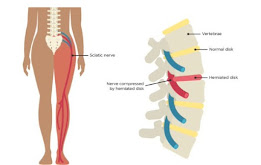Sciatica
Sciatica is nerve pain that radiates along the course of the sciatic nerve i.e. from the lower back to buttocks, legs, and feet. It is a common neurogenic disorder affecting 50% of people, especially women during pregnancy - due to pressure on the sciatic nerve from the developing uterus.
What is Sciatica?
Sciatic Nerve:
Causes and Symptoms:
The main cause of Sciatica is the pinched nerve (nerve compression) due to injury, herniated disc, piriformis syndrome, spondylolisthesis, arthritis of the vertebral column, bony spur on the spine, or spinal stenosis - the narrowing of the spinal canal. This is also known as "True Sciatica" - the radiating pain due to injury.
Sometimes sciatica is confused with every low back pain or buttock pain that does not radiate down the legs.
 |
| Causes |
- Pain that radiates down the course of the sciatic nerve i.e. from the lower back to hips, legs, and toes.
- Burning or sharp and shooting pain.
- Numbness
- Tingling
- Muscle weakness in legs
- Pain during long sitting or long-standing.
- Pain while sudden body movements for example cough and sneezing.
Diagnosis:
- Start by taking a medical history.
- Inquire about recent injuries.
- Ask the patient about the intensity, duration, and location of the pain.
- Check if it radiates down the entire course of the sciatic nerve.
- Ask about the character of pain i.e. if it is sharp or shooting and what makes the pain feel better and what aggravates it.
- Do a thorough physical exam. Ask the patient to walk on their heels and toes and check how their spine carries their weight.
- SLR - Perform Straight Leg Raises and check the pinpoint location of the pain.
- X-ray - If your spine has anything abnormal like bony spurs causing compression it will detect it.
- MRI - As MRI can produce a detailed image of soft tissues as well, it will detect the herniated disc pinching the nerve.
Treatment:
Self-care:
Pharmacological Management:
- Muscle relaxants (Cyclobenzaprine)
- Acetaminophen
- NSAIDs (Ibuprofen, aspirin & naproxen etc.)
- Tricyclic antidepressants
- Anti-seizure medications
Physical Therapy:
 |
| SLR |
- Stretching exercises to enhance flexibility.
- Knee to opposite shoulder stretch.
- Side-lying hip stretch
- Straight leg raise - SLR
- Back lying hip stretches
- Exercises to improve mobility.
- Exercises to counter the nerve compression.
- Hamstring stretches
- Gluteal Stretch

Knees to opposite shoulder
Epidural Spinal Injections:
Surgery:
- Microdiscectomy (removing the fragments of a herniated disc that are causing compression)
- discectomy (removal of the whole disc)
- Laminectomy (removal of lamina that is causing this compression)
Risk Factors:
- Age
- Pregnancy (as a growing uterus or additional weight puts an immense amount of pressure on the spinal cord)
- Tobacco Smoking (Nicotine in tobacco smoke is directly responsible for IVD degeneration as it causes cell damage in both annulus fibrosis and nucleus pulposus)
- Lifting heavy objects (this causes strain on back muscles)
- Long sitting
- Long-standing
- Obesity
- Diabetes (as high blood glucose levels cause nerve damage)



.jpg)
It's really really amazing 🤩
ReplyDeleteEvery 2nd person's problem! Thanks
ReplyDeleteGreat information 🙂
ReplyDeleteThanks Maèstrò
ReplyDeleteMuch informative as usual♥️
ReplyDeleteThank you for this information
ReplyDelete